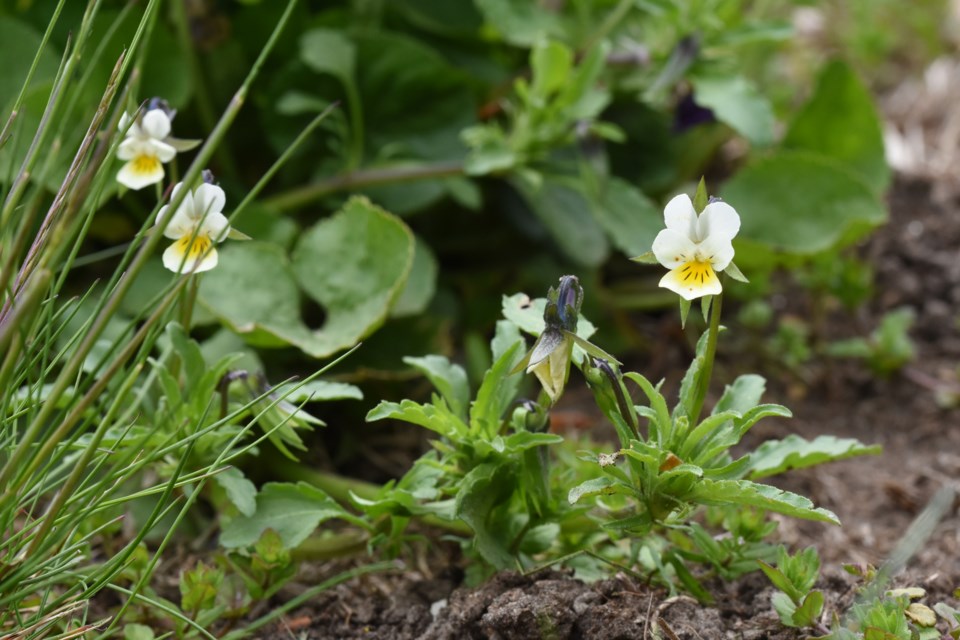Each spring we succumb to the grand idea to improve the looks of the landscape around our home, the most obvious endeavour usually being the flower gardens. Daffodils, tulips, periwinkles, hyacinth and crocuses have all been lined up rank and file to beautify the grounds (although the periwinkle refuses to stay in neither rank nor file).
However, being a wildflower aficionado, I find something lacking; these garden species look a bit too domestic for my liking.
In search of wilderness, a short walk around the lawn (and some grass manicurists would shudder at my use of the word "lawn"), reveals that nature has been gardening, too — with much better results than I. Mixed within the twitch, crab, Kentucky blue, and orchard grasses of our mowed green space is found a delightful variety of wildflowers.
Scattered about, and increasing their coverage every year, are several species of violets, their yellow, white or blue blossoms peeking coyly from between the clumps of what I assume would be hay if left unfettered. Each May our lawn is a patchwork of colour due mainly to these ground-hugging flowers.
Violets, historically, have been revered and honoured in many myths and writings. Legend has it that Zeus fell in love with the nymph Lo, but for some reason his wife, Hera, didn't take kindly to the situation — so she changed Lo into a white heifer. Unable to change her back, Zeus managed to have Io's tears turn into violets as they dropped to the ground.
For over 2,000 years these flowers have been cultivated and utilized by the people of Europe as perfumes, candies, cancer treatments, remedies for ailing stomachs and throbbing heads. In 1475 Thorlief Bjornsson, an Icelander, wrote: "If a man's head is heavy from meat or drink, then it is good to drink violets. If one has on his head a wreath of violets, it drives away vipers with its smell."
The Roman naturalist, Pliny, also noted that a garland of violets worn about the head would cure dizziness and banish headaches. The Celts discovered that a mixture of goat's milk and violets made an acceptable cosmetic, and the English found that this flower could be used as a mild laxative for children.
This sweet-scented flower was also adored by the famous Napoleon and his Josephine. She wore violet perfume in such extremes that it quickly became her trademark (easier than bathing, I guess). When she died in 1814 Napoleon planted these flowers on her grave, eventually picking some which he encased in a locket that he wore until his own death.
Today violets are still held in special wonderment. While our native species lack odour, the imported varieties from Europe have abundant smell, which is almost overpowering when sniffed too long or too close.
There is a chemical within violets called ionone (perhaps so named in honour of Zeus’ failed romance?), an element that temporarily numbs the sense of smell. Upon smelling this blossom your nose registers the fragrance, short-circuits for a moment, and then once more becomes capable of smelling.
As Shakespeare so aptly put it: "The odour of a violet is forward, not permanent; sweet, not lasting; the perfume and suppliance of a minute."
Also found in our humble yard are the multi-coloured blooms of a little violet called a field pansy. The name 'pansy' is from the French word 'pensee', meaning 'thought'; and when looked at these small, richly coloured blooms do indeed have pensive, or thoughtful, faces.
Field pansies are also called Johnny-Jump-Up, as they grew in profusion within old battlefields of the far south. And yet another name is Heartsease, coming from the traditional language of flowers in which purple means memories, white means loving thoughts, and yellow stands for souvenirs. Hence, heartsease was a flower received in happy memory to ease the heartbreak of separation.
Once the history and relevance of a "weed" becomes known, it is hard to whack it down with a lawnmower or spray it with chemicals. Maybe I should just change the name of our flat area from yard to wildflower garden, and not spend too much time fussing over it. Besides, I’ve been told that a lily bed needs to be moved 30 feet to the right.
